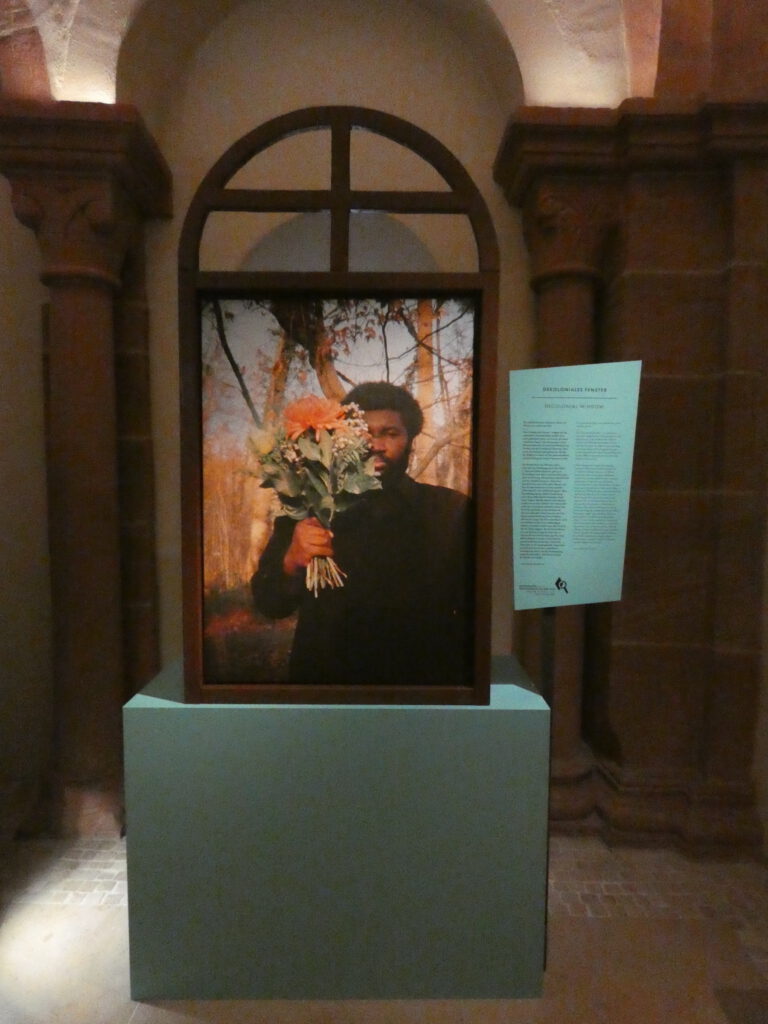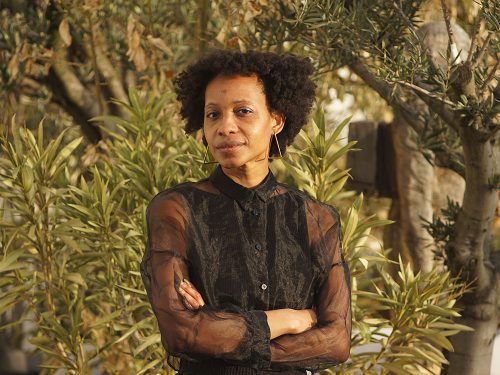Ana Paula dos Santos (@dossantos_ana_paula) is a self-taught photographer whose practice is shaped by her coming of age in Brazil as well as her study of human geography and “decolonial studies,” which gave her a language to put the experiences from her childhood and youth in Brazil into words and to grasp and understand these experiences within a broader context. Dos Santo’s understanding of colonialism also led to a self-awareness that, as a Brazilian living in Germany, she wants to challenge stereotypes of the “exotic object” viewed as a sight from a distant country and through a colonial lens, in her work.
In her love for old and alternative cameras and her preoccupation with them, dos Santos has also found that exhibitions rarely present analog photography as a practice by Black women photographers. This led the artist to wonder if one can also feel the spirit of colonialism in this pattern, which is closely linked to the history of photography.
In 2014, dos Santos received a Bachelor of Arts degree in Cultural Anthropology and Romance Studies (Latin American Studies) and in 2019 she received her Master of Arts in Human Geography with a focus in Decolonial Debates in Art in 2019 from Johann Wolfgang von Goethe University in Frankfurt. Dos Santos’s work has shown at several institutions in Frankfurt, including the 1822-Forum and interventions at the Historische Museum. She is currently studying at the Hochschule für Bildende Künste – Städelschule, Frankfurt am Main and she is a member of the artists’ and architects’ collective COMMUNNE 6×3.
Ana in her own words:
“Find Me” (2021)
In meiner analogen photographischen Arbeit (“find me”) Presence/Absence beschaftige ich mich mit dem Paradoxon in dem Erleben eines Menschen, wenn diese sich gesehen und gleichzeigt uber- oder nicht gesehen fuhlt oder sich verhullen mochte, um sich selbst wahrnehmen zu konnen.
Wenn wir einer Person begegnen, haben wir in unserem Kopf ein geformtes Bild von dem, was wir oberflachlich sehen. Wenn wir die Person dann naher erfahren, wird dieses Bild immer wieder hinterfragt und neu entworfen. Aber fur viele rassifizierte Menschen bleibt es bei dem vorgeformten Bild, mit dem sie sich abzufinden haben, und Ihnen werden Platze zugewiesen, wo sie sein sollen und Rollen ubergestulpt, die sie zu erfullen haben.
“Find me” ist eine Form der Reflexion und des Empowerments für alle Menschen, die rassifiziert und subalternisiert wurden, damit sie die notwendige Kraft gewinnen können, den Zuschreibungen und Markierungen zu wiederstehen und nicht aufgeben einzufordern, als emanzipiertes Subjekt behandelt zu werden.
Die Portrats zeigen BIPoC (Black,Indigenous and People of Color), die von BIPoC in Szene gesetzt werden, die ein Gespur und Verständnis fur Situationen der Rassifizierung und Subalternität aus eigenen Erleben bekommen haben und diese erkennen konnen. Ich habe mit dieser Serie begonnen, indem ich meine eigenen Freunde fotografiert habe, und die Idee ist, andere Menschen zu fotografieren, die mir nicht so nahe stehen, aber dieselben Erfahrungen machen.
Die fotografierten Personen werden mit verdeckten Gesichtsteilen erscheinen. Dies zeigt Schutz, An- und Abwesenheit gleichzeitig und die Moglichkeit, ihre eigene Geschichte zu erzahlen, indem sie ihrem Sein neuen Raum geben. Die Bilder werden metaphorisch und frei fur Interpretationen sein.
Die Helligkeit des Objekts, mit welchem die Gesichter verdeckt werden, hat die Intention auf die Helligkeit zu verweisen, die verborgen war und reflektiert nun doppelt das Licht und das Geheimnis. Gesehen und versteckt zugleich, will es verborgene Antworten erforschen, die die Geschichte zu verbergen versucht hat, wie zum Beispiel, was es bedeutet.
Zwei Zitaten von bell hooks sagen:
„The practice of freedom in daily life, and that includes artistic freedom, is always a liberatory act that begins with the will to imagine.“ bell hooks – Visual Politcs
„(…) I Think about the place of art in black life, connections between the social construction of black identity, the impact of race and class, and the presence in black life of an inarticulate but ever-present visual aesthetic governing our relationship to images, to the process of image making (…) to consider the place of the visual in black life – the importance of photography.“
bell hooks – Black Looks
“Find Me” (2021)
In my analogue photographic work (“find me”) Presence/Absence I deal with the paradox in the experience of a person when they feel seen and at the same time over- or not seen or want to cover themselves up in order to be able to perceive themselves.
When we meet a person, we have a formed image in our minds of what we see on the surface. Then, when we experience the person more closely, this image is always questioned and redrawn. But for many racialised people, the pre-formed image is what they have to put up with, and they are assigned places to be and roles to fulfil.
“Find me” is a form of reflection and empowerment for all people who have been racialised and subalternised, so that they can gain the necessary strength to resist the attributions and markings and not give up demanding to be treated as emancipated subjects.
The portraits show BIPoC (Black,Indigenous and People of Colour) staged by BIPoC who have gained a sense and understanding of and can recognise situations of racialisation and subalternity from their own experiences. I started this series by photographing my own friends and the idea is to photograph other people who are not so close to me but who live the same experience.
The people photographed will appear with parts of their faces covered. This shows protection, presence and absence at the same time and the possibility to tell their own story by giving new space to their being. The images will be metaphorical and free for interpretation.
The brightness of the object with which the faces are covered has the intention to refer to the brightness that was hidden and now doubly reflects the light and the mystery. Seen and hidden at the same time, it wants to explore hidden answers that history has tried to conceal, such as what it means to …
When I was a child and teenager in Brazil, I was always looking for an example for me to follow. I didn’t see myself in public places and important public positions, so I thought that things weren’t made for me. I looked for myself, but deep down I knew that my imagination was fertile and that I existed and that sometimes some greater force prevented me from appearing. In the end, I found myself in my family and friends and began to visualize what I wanted to be outside the bubble of coloniality.
Two quotes from bell hooks say:
„The practice of freedom in daily life, and that includes artistic freedom, is always a liberatory act that begins with the will to imagine.“ bell hooks – Visual Politcs
„(…) I Think about the place of art in black life, connections between the social construction of black identity, the impact of race and class, and the presence in black life of an inarticulate but ever-present visual aesthetic governing our relationship to images, to the process of image making (…) to consider the place of the visual in black life – the importance of photography.“
bell hooks – Black Looks
“Decolonial window
– An autonomous Black man with flowers at the window of time” (2022)

The ‘Decolonial Window’ is a reaction to the racist representation in the painting ‘A richly dressed Lady at the Window with a Black servant’ in the Morgenstern’sches Miniaturkabinett. The gaze on whiteness as a privilege and the portrayal of Black people as props is interrupted.
In this image you can see the image of the Morgen`sches Miniaturkabinett and the image inside of the Kabinett that was intervented. This images are in the Historical Museum in Frankfurt am Main:
Even the title of the painting points out the different societal positions of the two people in the painting. When Morgenstern copied the painting 200 years after it was made by the painter Caspar Netscher (1660), there was no critical discussion about enslavement, Blackness, subalternity and the objectification of people taking place in Germany yet. Artists like Carrie Mae Weems and Titus Khapar criticised these types of portrayals in their works ‘After Manet’ and ‘Shifting the gaze’. So what meaning might this painting hold for viewers today? Which power and colonial structures does it uncover?
The art intervention places the man who stands in the shadows in the Netscher painting in the centre.It shifts the focus away from the privileging of whiteness (Visual Politics, Bell Hooks, 1995). Here, the Black person is portrayed as a confident and independent subject. Freed from the prejudice of immaturity which colonialism has inscribed in our thinking, it becomes an act of decoloniality. The new painting confronts the different societal positions of Black people in the past, present and future. The window symbolises change, a place of observation, perhaps a stage. The flowers represent dignity and emotion

